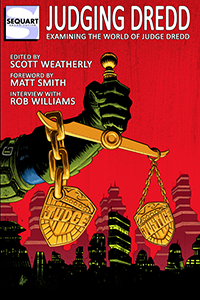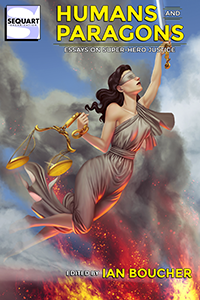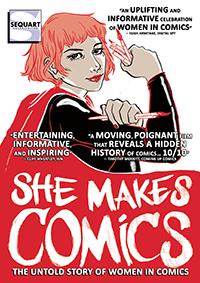Earlier, we discussed how Dredd is faithful to its source material, to the extent that it could be described as a violent morality play. Today, I’d like to discuss the film’s narrative choices, because I think they’re both smart and unorthodox, especially for a first film. As before, be aware of spoilers.
This isn’t Deconstruction, but Neither is it a Year One
One of the problems of adapting Judge Dredd to cinema is that the most celebrated Judge Dredd stories are all ones that upset his – and Mega City One’s – status quo. But this has no weight, if viewers don’t already care about the characters and their status quo.
For example, “The Cursed Earth” sees Dredd abandon Mega City One, wander the radiated American landscape, and return to address corruption at the top levels of his city. This beloved storyline – an early landmark for character – certainly seems like suitably dramatic material, and it’s probably for this reason that it (combined with other elements) formed part of the basis of the 1995 film Judge Dredd, starring Sylvester Stallone.
Yet none of these events mean anything, if we don’t already care about the status quo it upsets. Dredd’s exile doesn’t have weight, unless we’re already invested in seeing him as the ultimate Judge. Mega City One’s corruption means nothing, if we don’t already understand the Law as the unbending basis of Dredd’s worldview. And twenty minutes isn’t enough to get viewers to care about the status quo before it’s broken.
Perhaps the most famous Dredd villain is Judge Death, who has wreaked wholesale destruction upon Mega City One on more than one occasion. Yet this doesn’t mean anything unless we already care about Mega City One and are used to stories without such widescale destruction.
Dredd’s writer, Alex Garland, reportedly focused on Judge Death in his first script, before coming around to the idea that this deconstruction of the Judge system didn’t work because the Judge system hadn’t been previously established.
It’s a simple observation, but it’s one of the key rules of fiction: deconstructing a character or destroying something doesn’t mean anything unless the audience already cares about that character or thing. You have to establish the status quo before you break it.
For Judge Dredd, this is a problem, because there aren’t many famous or celebrated stories that feel like “status quo” tales. If you read the earliest Dredd tales, which tend to be remarkably short, you’re thrown right into the action, in medias res. Collectively, they establish most of the elements of the Judge system and Mega City One, but there’s not a single story begging for adaptation.
One solution might be to turn to a “Year One” story – the kind of origin story popularized by Batman Begins. This has become a popular tactic, in the wake of Batman Begins, and can also be seen in Casino Royale and plenty other franchise reboots. For a reboot, this has the added advantage of appearing to start at the beginning, yielding an opportunity to “get things right” this time, laying a foundation for more explosive sequels.
Yet this has now become a bemoaned cliché. And it’s a tactic that seems particularly at odds with Dredd. True, Dredd’s origins have been explored in the comics, especially in 2006’s extended “Origins” storyline. Alex Garland reportedly considered this option too. But those stories have weight because they upset the status quo in their own way, by revealing its origins. They’re not where anyone would suggest someone unfamiliar with Dredd begin.
Dredd is, first and foremost, an uncompromising man on a motorcycle, empowered to act as judge, jury, and executioner in the harsh environment of Mega City One.
Dredd as Skyscraper Story
The best solution for Dredd is thus to come up with a new “status quo” storyline – one establishing Mega City One and the Judge system, while also delivering a story that feels suitably large and dramatic.
Borrowing from the emphasis on different blocks and their feuding gangs, a recurrent element in the comic, is an inspired idea. It allows the film to characterize Mega City One as part of its basic plot, rather than artificially grafting such elements on.
Through this choice, Garland is also able to dramatize the suffering of impoverished people living under constant threat of violence, an element almost always present in the comics. We may focus on Dredd, but the comics frequently show us that many citizens don’t have the kind of opportunities and choices that would allow them to avoid the long list of crimes enforced by the Judges. This acts as an important counterbalance to the seductiveness of Dredd and the uncompromising Law he enforces. Without this counterbalance, Dredd is little more than a fascistic fantasy, so it’s an essential element of the series.
It’s an element Dredd doesn’t veer away from. The Peach Tree block feels like the most disgusting of ghettos, all but bereft of police protection. We in the West recognize it instantly from our own concrete “projects,” those utopian towers that have long since become symbols of endemic poverty and gang violence. Pity the poor souls trapped in such places, with no way out. Especially when the alternative is an unbending, uncompromising Law, which punishes criminals enthusiastically and at great expense, but cannot or will not lift those struggling souls out of such poverty.
Such tensions are implicit in Judge Dredd. They are sometimes the subject of a story, but they are usually part of the comic’s subtext. Without turning an action story into a philosophical or preachy social critique, such elements add layers that undermine and even disrupt any simple interpretation. They are part of the richness of Judge Dredd, and they operate at precisely this subtextual yet obvious level in Dredd.
There’s even a literary tradition of using the skyscraper as a microcosm, through which to dissect social issues. Watching Dredd, I couldn’t help but think of J. G. Ballard’s brilliant High-Rise, in which a rather more posh skyscraper shuts itself out from the outside world and becomes a kind of island, in the style of Lord of the Flies, through which human beings descend into gang warfare and all sorts of animalistic or primitivistic behavior. To be sure, Dredd isn’t a work of literary transgression like High-Rise, which takes a scalpel to our social preconceptions. Nor is that the action movie’s function. But to riff in this direction is high praise for an action flick, adding subtext and layers to the entertainment on display that makes it greater than the sum of its parts.
It’s a delicate balance, but one intrinsic to Judge Dredd. And one Dredd gets right.
An Iconic Villain
This new, status quo-establishing story also needs a villain. Like its setting, Dredd’s villain also reflects and helps characterize Mega City One.
Ma-Ma, played brilliantly by Lena Headey, is a child of the city’s tough, largely unpoliced environment. To see her scarred face is to be reminded of this violent past, in which she was a prostitute.
But it is also to see her own capacity for violence. We’re told that, in response to her injury, she bit the perpetrator’s penis off. Because her winding facial scars remain reddish, they still recall the trickling of that blood.
Not only is this powerful imagery for a villain, but it’s charged with meaning.
In a psychological reading of the character, it’s interesting that her castration of her pimp marked the beginning of her rise to power. The phallus is a symbol of dominance and power, and she had to remove her oppressor’s biological penis – with her teeth, no less – in order to acquire his phallus, his power.
This story also allows the character to play on the audience’s castration anxiety, and one sequence uses this for dramatic effect.
The story of Ma-Ma’s origins also roots her own ruthlessness in the horror that is Mega City One. She can seem inhumanly amoral, but she wasn’t born that way. She was made that way through prostitution and violence. She learned the lesson that one has power in proportion to one’s ruthlessness.
Her ability to adapt to the rules of the game, as she has learned them, reflect remarkable intelligence and determination. Like many great villains, it’s hard not to have a certain admiration for her. As despicable as her actions are, she is the product of her background, to which she has adapted well.
As a villain, the ruthless Ma-Ma recalls one of the most famous movie villains ever: Khan, most famously from Star Trek II: The Wrath of Khan. Khan’s battle with Kirk is certainly more personal, and he’s motivated by a desire for revenge. But what makes Khan so distinctive is his intelligence, the way the entire film feels like a protracted chess game of ruthlessly smart maneuvers, and Dredd has much of this same feel.
While she might not be motivated by revenge, Ma-Ma — introduced in a scene in which she orders men skinned alive and thrown to their deaths — probably has Khan beaten on the ruthlessness scale. And thanks in part to her scar, Ma-Ma is probably even more visually distinctive.
It’s hard to overstate what high praise this is, especially for a first film, designed to establish a status quo. Many filmmakers have cited Khan, but their imitations usually feel pale in comparison. With the rise of the super-hero franchise, many filmmakers have come to see the first film as establishing a character’s origins and status quo, leaving room for a Khan-like villain in the sequel.
To achieve such a memorable villain is remarkable enough. To do so in a first film, in a time when much popular wisdom would advise against even trying, is even more remarkable.
So too is her death. Great villains need great deaths, after all.
Ma-Ma seems to have been waiting for someone to depose her. She’s taken precautions, but her background informs her that someone’s always gunning for you. Her mentality is dog-eat-dog, and there’s always a bigger dog – or one that gets lucky. She seems to accept this, in a strange way.
It’s true that the device that Ma-Ma wears is one of the film’s weaker points. We’re told it would trigger explosives, killing many floors of residents. But typically, such failsafe devices routinely send out a signal, perhaps tied to a heartbeat, and the interruption of the signal triggers the bomb (or other device). This failsafe seems to send out a signal upon death, and that makes the story work. But had Ma-Ma worn a more typical version of the device, her death would have had to happen differently. And movie viewers are accustomed enough to the typical version that they’re likely to be at least briefly confused.
That’s easy to forgive, however, given the beauty of Ma-Ma’s death. It mirrors the violence she has committed, in the scene in which she’s introduced. But the death sequence is also visually stunning. Few villains have ever been given a more beautiful or memorable exit.
Judge Anderson
It’s a truism that an audience identification figure is one of the best ways of introducing an exotic world, characters, or elements. Even if the character isn’t really new to the story’s exotic setting, such a character still gives the protagonist someone to talk to, allowing plans to be explained that might otherwise mystify the audience.
Thus, Robin lets Batman explain his devices and his motivations, which has the added bonus of appealing to kids.
The utility of such an outsider character to the future world of Judge Dredd is obvious enough. In fact, such a character was used in the first Judge Dredd film. There, comedian Rob Schneider played a goofy criminal who, through bizarre circumstances, becomes Dredd’s sidekick. The character is not fondly remembered.
For Dredd, this role is played by the psychic Judge Anderson, one of the most beloved characters of the Dredd mythos. Introduced in 1980, she became one of the first Dredd characters to star in solo adventures. The best of these had an introspective, philosophical, or mystical quality that Dredd’s own stories lacked. Indeed, part of the appeal of Anderson was as a foil for Dredd — one female and mental, the other male and physical.
In Dredd, Anderson — played by Olivia Thirlby — is still a rookie, and the film takes place during her field evaluation, supervised by Dredd. He points out the high mortality rates faced by new Judges, so the violence of the film serves to dramatize the difficulty of their job. But audiences will also recognize the parallels to Training Day, despite the futuristic setting. It’s another genre, like the skyscraper story, that adds another layer to the film.
Anderson’s also crucial to the film’s rather complicated depiction of gender. In a genre typically defined by musclebound men, it’s notable that both the villain and the protagonist’s sidekick are women.
Neither character is depicted sexually in any stereotypical way, yet both characters’s depictions are defined by their sex. Ma-Ma, as previously stated, has gained her power through literally emasculating her predecessor — an act of great sexual violence. Anderson is also threatened, implicitly and explicitly, with sexual violence — gang rape, to be precise. Yet this isn’t glamorized, or used for titillation. It’s never depicted as anything but brutal, and it characterizes the violence of the Peach Tree block — and Mega-City One in general.
Anderson also commits rape herself. Her psychic powers, although true to the comic-book source material, might repel some members of the audience, who prefer more narrowly realistic urban dystopias. But the film’s depiction of these powers is consistently marvelous. In one beautiful but brutal scene, Anderson turns the tables on a criminal, invading his mind and essentially breaking him. In his mind, he’s even put in the position of the pimp Ma-Ma emasculated. It’s a graphic sequence of violent reversal, and it’s hard not to realize that Anderson’s psychic trespass is morally questionable, if not actually a kind of rape.
Like Ma-Ma, Anderson’s also an extraordinarily strong character. In action films, female characters tend to either be helpless damsels in distress or kick-ass martial artists themselves. While this second category has been celebrated by some as a step forward in gender depictions (“Women are kicking ass too!!!”), these depictions are usually every bit as shallow as the shrieking girlfriends of old. Their martial arts often defy physics even more than their male counterparts. (Black Widow, in Iron Man 2 and The Avengers, is especially laughable and offensive in this regard.) The end result is too often “bad-ass” women who look like supermodels but whose behavior is so hyper-masculine that it would be recognized as unintentional parody, were the character actually male. The result often manages to combine unattainable female bodies with even less attainable, if not physically impossible, strength and fighting skills. While superficially granting a female character “agency,” the result can sometimes manage be even more offensive than the old-school weeping housewives, which — crude as it was — at least acknowledged gender difference and thus gender at all.
Anderson, like Ma-Ma, avoids this completely. Ma-Ma is hardened, and Anderson is an uncertain rookie. Neither are depicted knocking 300-pound henchmen down with roundhouse kicks from their slender legs. But both are extraordinarily capable and determined. They remain gendered, but are clearly forces to be reckoned with.
Like Ma-Ma, Anderson’s also wicked smart. The most telling moment, in this regard, is when she tells Dredd that she’s already failed her examination. Attentive viewers will have recognized this fact already, but it’s one that most stories would wait until the very end to mention, making possible a last-minute twist. Instead, Anderson acknowledges what smart viewers will have already recognized. She takes accountability, without apology, and then proceeds to send the film in another direction — one far more interesting than had this observation been saved until the final few minutes.
Thus, while Anderson might be a rookie and Dredd’s sidekick in the film, she takes a moral stand, in defiance of a strict interpretation of the Law, and thereby inspires Dredd through example.
I dare say that, despite her psychic powers, Anderson a far more aspirational figure than virtually any other female action heroine.
Such observations about gender are not a digression from our discussion of Dredd‘s narrative choices. Again and again, faced with narrative difficulties — such as the lack of a clear story to adapt, or the need for a strong villain, or the need for an audience identification figure – Dredd solves these problems in ways that add to the film, opening up multiple levels of meaning and interpretation. The film weaves these elements so seamlessly into the narrative that it’s easy to forget these were problems that needed solving in the first place. Never does one get the sense of lemons turned to lemonade. Instead, Dredd pivots, turning disadvantages into advantages — not merely solving these problems but turning them into narrative possibilities with layers of depth all their own.
The result a case study in smart adaptation, one worthy of studying for writers as well as critics.































































